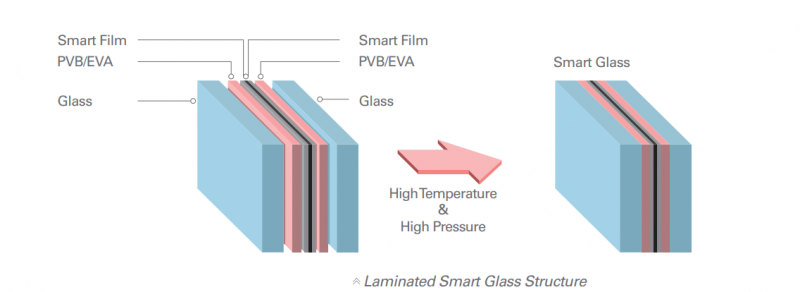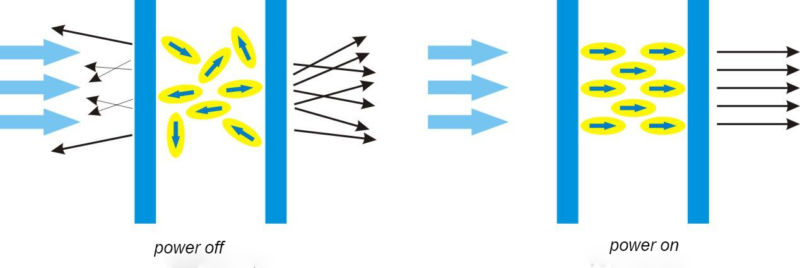Switchable PDLC Film Smart Glass Introduction
Contents |
[edit] What is switchable glass?
Switchable glass is also called smart glass or privacy glass, and is a new building material that combines smart film with glass. This is an innovative opto-electrical laminated glass composed of two layers of toughened glass on the outer side, PDLC film in the middle and other composite materials to form a sandwich-like structure. All those materials stick together firmly through special lamination machinery.
When powered off, it is opaque; when powered on, it turns transparent instantaneously. It’s a safety glass that act as smart projection screen too. A variety of glass can be used, such as insulating glass, laminated glass, art glass, fireproof glass, etc.It can be widely used in room partitions,curtain walls,glass doors and windows.
[edit] Reasons to use switchable glass
- When broken it will stay on the original frame so that people nearby will not be injured.
- There is no need for blinds or curtains.
- It can save on air conditioning costs due to its insulation and 99% opacity.
- It is multi functional, use rear projection to create a screen,or shopping window advertising.
- Reduce the cleaning and maintenance associated with traditional windows and window coverings.
- Use a mobile app to control it.
- It can last at least 15 years.
[edit] PDLC fim
PDLC (Polymer Dispersed Liquid Crystal) film is basically three-dimensional structures composed by liquid crystal microdrops dispersed in a polymer matrix. Polymer-dispersed liquid crystal (PDLC) films are useful in light control applications because they can be switched electrically between light scattering and transparent states.
Flexible PET film with conductive material coated by a “smart web” ITO film. The percentage of conductive material and PET film quality is a key factor in making PDLC film of good quality with high transmittance and resistance to shocks. The liquid crystal is sandwiched between the 2 ITO films by a lamination machine to make the PDLC film.
Other names for smart glass include; switchable glass, switchable film, PDLC film, privacy glass, dimmable glass, dimming glass, electronically controlled glass, LCG® (light control glass), liquid crystal glass and switchable windows.
Non-adhesive PDLC film is the original material for laminated smart switchable glass.
Self-adhesive PDLC film has a peel and stick backing for easy installation, it’s widely used in commercial and residential fields like shopping windows, projection screens, electronic blinds, and so on.
Smart Glass is compatible with most types of internal partition systems including sliding panels, IGU partitions and windows, and U or T profiles from most materials.
Depending on the different manufacturers, PDLC can be made in grey, various colours, with patterns or with temperature control formulations that increase green points in buildings.
PDLC glass is typically used for indoor applications, but some companies have outdoor grade technologies.
It consumes 5-7 watts per sqm. For perspective: 10sqm of PDLC switchable glass consumes less energy than one LED bulb
[edit] Related articles on Designing Buildings
Featured articles and news
UK Infrastructure: A 10 Year Strategy. In brief with reactions
With the National Infrastructure and Service Transformation Authority (NISTA).
Ebenezer Howard: inventor of the garden city. Book review.
The Grenfell Tower fire, eight years on
A time to pause and reflect as Dubai tower block fire reported just before anniversary.
Airtightness Topic Guide BSRIA TG 27/2025
Explaining the basics of airtightness, what it is, why it's important, when it's required and how it's carried out.
Construction contract awards hit lowest point of 2025
Plummeting for second consecutive month, intensifying concerns for housing and infrastructure goals.
Understanding Mental Health in the Built Environment 2025
Examining the state of mental health in construction, shedding light on levels of stress, anxiety and depression.
The benefits of engaging with insulation manufacturers
When considering ground floor constructions.
Lighting Industry endorses Blueprint for Electrification
The Lighting Industry Association fully supports the ECA Blueprint as a timely, urgent call to action.
BSRIA Sentinel Clerk of Works Training Case Study
Strengthening expertise to enhance service delivery with integrated cutting-edge industry knowledge.
Impact report from the Supply Chain Sustainability School
Free sustainability skills, training and support delivered to thousands of UK companies to help cut carbon.
The Building Safety Forum at the Installershow 2025
With speakers confirmed for 24 June as part of Building Safety Week.
The UK’s largest air pollution campaign.
Future Homes Standard, now includes solar, but what else?
Will the new standard, due to in the Autumn, go far enough in terms of performance ?
BSRIA Briefing: Cleaner Air, Better tomorrow
A look back at issues relating to inside and outside air quality, discussed during the BSRIA briefing in 2023.
Restoring Abbotsford's hothouse
Bringing the writer Walter Scott's garden to life.
Reflections on the spending review with CIAT.
Retired firefighter cycles world to raise Grenfell funds
Leaving on 14 June 2025 Stephen will raise money for youth and schools through the Grenfell Foundation.
Key points for construction at a glance with industry reactions.


























Comments
At 6W per square metre, that means 10 square metres is 60W. That is a lot more than an LED bulb unless you're talking something seriously bright. It's more like the consumption of an old fashioned incandescent bulb.